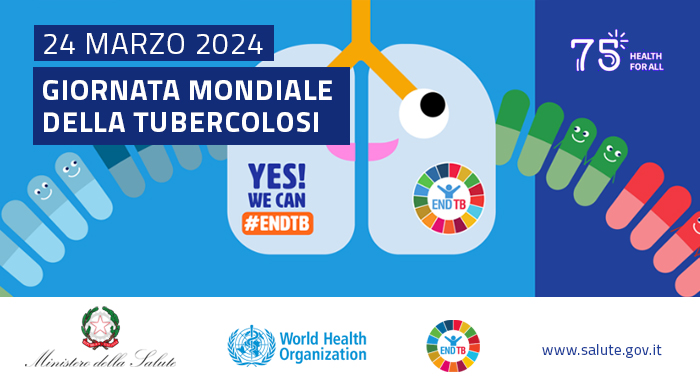World Tuberculosis (TB) Day is celebrated on 24 March each year in memory of 24 March 1882, when Robert Cook announced to the scientific community the discovery of the etiological agent of this disease.
The WHO message
World Tuberculosis Day 2024 (TB Day) is commemorated with the theme “Yes! We can end TB!“ (Yes, we can put an end to tuberculosis!), which conveys a message of hope about the possibility of resuming the fight against the tuberculosis epidemic, thanks to a leadership at a high level, to greater investments and faster adoption of the new WHO recommendations.
On the occasion of World Day, to ensure the achievement of the commitments undertaken, the WHO calls for action on various fronts:
leadership and high-level action to end TB as a public health problem sustainable investment in resources, support, care and information to ensure universal access to treatment and research increase access to TB preventive treatment and treatment services screening for tuberculosis disease strengthening multisectoral commitment and responsibility actions to address health inequalities and guarantee health for all. The epidemiological picture
Since 1997, the WHO has published the Global tubercolosis Reporta report that provides a comprehensive and up-to-date assessment of the TB epidemic and progress in prevention, diagnosis and treatment of the disease, at global, regional and national levels.
To TB in the world it was there second leading cause of death from a single infectious agent in 2022after the Covid-19 disease.
the Covid-19 pandemic caused by the SARS-CoV-2 virus has had a strong impact on tuberculosis surveillance, prevention and treatment activities: it is estimated that around 10.6 million people developed TB in 2022, compared to estimates of 10.3 million in 2021 and 10.0 million in 2020 TB caused approximately 1.30 million deaths, down from estimates of 1.4 million in both 2020 and 2021 and almost at the 2019 level in 2022, 55% of people who developed TB were men, 33% women and 12% children (0 to 14 years) multidrug-resistant or rifampicin-resistant TB (MDR/RR-TB) still represents a serious public health problem and a threat to health security: an estimated 410,000 people will have developed MDR/RR TB in 2022: among these, only two in five people have been diagnosed and started on treatment.
L’Italia is defined by the WHO as a country “low endemic”, since there are fewer than 10 cases of the disease per 100,000 inhabitants.
in 2022 they were notified 2.439 cases of tuberculosis, with a notification rate of 4,1 cases per 100,000 residents; from 2010 to 2021 the disease notification rate progressively reduced (from 7.7 to 4.2 per 100,000 residents), reaching the lowest value in 2020 (3.8 per 100,000 residents); this decrease occurred in all age groups; in 2022 there were 1683 cases of pulmonary TB (69.0%): this ratio between pulmonary and extra-pulmonary forms remained constant in the period 2009-2021; in 2022 the percentage of TB cases in those born abroad remains slightly higher than that recorded for people born in Italy, however the absolute numbers are decreasing among those born abroad. The global strategy and Italy’s objective
Global strategy “End TB”adopted by the World Health Assembly in 2014, aims to
reduce the incidence of TB by 80% compared to 2015 reduce deaths from TB by 90% compared to 2015 completely eliminate catastrophic costs for families affected by TB by 2030.
In the European context theAction plan 2023-2030 of the WHO European Region provides:
reducing TB incidence by 50% by 2025 and 80% by 2030 reducing the number of TB deaths by 75% by 2025 and 90% by 2030 achieving the success rate among MDR cases and RR-TB of 80% by 2025 and 85% by 2030.
Italy currently aims to achieve the objectives for low-endemic countries defined in the strategy “End TB” starting from countries that had fewer than 100 cases per million in 2012):
pre-elimination phase: fewer than 10 cases per million in 2035
elimination phase: less than 1 case per million by 2050.
The objectives to be achieved include the improvement of treatment, case management and adherence to therapy, as well as support for the integration between local health services and other bodies (public, private social and voluntary), with the aim of promoting access to health services by the entire population.
The activities of the Ministry
The Ministry of Health, together with the Regions and Autonomous Provinces, has developed guidelines aimed at preventing TB in relation to the management of contacts, the healthcare environment and populations coming from highly endemic countries.
As part of the activities of the National Center for Disease Prevention and Control (CCM), as a coordinating body between the Ministry of Health and the Regions for surveillance, prevention and timely response activities to emergencies, projects have been financed aimed at defining strategies for the control of HIV-associated tuberculosis and the control and prevention of the infection and tuberculosis disease, with the aim of reaching the phase of pre-elimination envisaged by the “End TB” strategy.
To know more
